Ron Ludekens
Pruning Blackberries
Question: When do I trim back blackberry bushes, this was my first year with planting the Chester's last spring (we had no fruit this year) - Glen
Answer: Glen, I see I need to take time to write a more detailed article on berry pruning (later). For now the quick answer with links to others.
Chester fruits on second year wood (Floricanes). This means the new growth that you see this year will produce the fruit for you next year. So do not prune off this growth until after it fruits next year. Once the cane has fruited, it can be removed since it will die anyway.
Here are some helpful and more thorough links:
Sugar Cane Jujube Pricing
Question: I am interested in sugar cane Jujube. Since it is a brand new variety, would the pricing on these plants be substantially more than other varieties of Jujube?
Paul.
Answer: Since the Sugar Cane variety will not be available until January 2011, I suspect there will be minor inflation adjustments over today's Jujube costs but not significantly different. Of course the prices the retail nursery charges is up to them and some of their charge may be dependent upon how many we are able to produce this next year and the demand that they see. High demand and moderate availability may affect pricing.
Fruiting Mulberries and Jujubes
Question: Interested in Mulberry and Jujube trees. Would order thru local nursery, but need information.
Prefer small to moderate. One party lives in Solvang, CA; 90's typical in summer and can freeze in winter. The other is in Santa Barbara in a location that rarely freezes, and average highs are in the 80s.
What varieties are most desirable? I had a Pakistan Mulberry and it tasted sweet but blah.
Answer: Leslie, thank you for your question. Cold weather will not be a problem in either of those beautiful locations for the trees you are looking for. They are in USDA Zones 7 and or 8 depending upon where you stand. Depending upon how close you are to the ocean in Santa Barbara for the summer fog may affect the Jujube fruit which likes the heat for the October fruiting.
We grow the following fruiting Mulberries: White Fruiting Mulberry (cold hardy to USDA zone 6), Cooke's Pakistan Fruiting Mulberry (our own selection) (Zone 7, maybe 6), Teas Weeping Fruiting Mulberry (Zone 3), Black Beauty Fruiting Mulberry (tree and bush forms)(Zone 4) and Persian Fruiting Mulberry (tree and bush forms)(Zone 4).
As you can tell by some of the names, the fruiting mulberry (Morus alba and Morus nigra) originated in the Middle East and Asia in areas with much harsher and colder weather than Solvang and Santa Barbara (an envious understatement!). The most cold sensitive fruiting Mulberry seems to be the Pakistan which has been sensitive to freeze in the first year or so on new, tender growth but survives the cold when more mature. It should not be a problem in Solvang or Santa Barbara.
You said smaller size is a consideration. The White, Pakistan and Persian get to be large trees. The Teas Weeping is a smaller tree with a weeping, mounding growth. The Black Beauty is semi-dwarf, getting to only 15 feet tall, but only 10-12 foot tall if purchased in bush form. Both produce small blackberry sized fruit. Although the Pakistan is probably too large for your application, I was surprised at your impression of the flavor. It has been our favorite of the fruiting mulberries for the fruit size and taste. Of course I favor sweet fruit so I may have to go back next summer and compare strength of flavor with other mulberries at the same time.
We offer four varieties of Jujube with a fifth slated for 2011 delivery. Li is by far the most popular due to its fruit size and that it was the first one we offered to the market many years ago. Lang seems to be losing ground as the second most favorite as our newer selections become better known. And both of those are very thorny. The third one we brought to the market is Sherwood. I was attracted to it since it had very few thorns and it was very sweet. It ripens a month later than the others but seems to set a little less fruit. Since the summers are not as hot or long on the coast, this might not be the best choice. The fourth one is the GA 866 which I also like and has grown in popularity. We have also tested the Sugar Cane fruit this summer and it is a winner too (again my sweet tooth). It will not be on the market until 2011 from our fields.
Honestly, I cannot tell you much about ultimate tree size of the Jujube. We prune our parent stock so heavy for the wood that we do not ever see a full sized tree here. I don't think there is enough difference in tree size to make much of a difference in your desire to select a smaller tree but I suspect Li and Lang are bigger based upon their re-growth and the Sugar Cane seems to have smaller wood suggesting possibly a smaller ultimate size.
So, based upon what little I know from your email. I would probably plant a Black Beauty Mulberry (tree or bush) and the GA 866 Jujube (or Sugar Cane if you can wait another year).
Enjoy.
Keith Davey Pistache Questions
Several questions have come in on the Keith Davey Chinese Pistache
Question: What is the difference between Keith Davey and the Chinese Pistache Seedling?
Answer: The Keith Davey Chinese Pistache (Pistachio chinensis) is a budded selection chosen for its superior fall color and seedless nature. By budding the wood from this tree we can duplicate these consistent and predictable characteristics for each tree planted. On the other hand, the seedling Chinese Pistache is variable. Like children, each tree is the product of pollinized seed and no two trees will be exactly the same. Some may have beautiful fall color while others may be weak. Some may be more yellow and others fiery orange-red. Some may set lots of seed while others a lot less. Keith Davey gives you predictability of a gorgeous, seedless tree.
See information flyers here: Keith Davey and Chinese Pistache Seedling
Question: Why will you only ship Pistache the first week of January?
Answer: Chinese Pistache do not like to be dug and shipped bareroot - there is a high loss factor which is why we did not grow them in the past. Due to high demand, we are growing them now but only with the proviso that we dig them on the last day of digging and ship within the next 1-3 days afterwards. Customers must plant or can them immediately upon receipt. There is no guarantee on these trees so losses are the risk and gamble of the receiving nursery. If we cannot ship them the first week of shipping, the items are removed from your order.
Question: Are these budded or grafted trees?
Answer: We bud the Keith Davey on the Pistachia chinensis seedling.
Note: Special Care needed promptly to handle them bareroot: Pistache Care Page
Late Season Peach
Question: I love peaches but do not have any to harvest after August. What late season peaches are available?
Answer: Over the years there have been many late ripening peaches offered through the nursery trade but the number of people passionate like you for late season peaches are fewer in number. Once school starts and the heat of summer fades, so does some of the gardening interest - at least until the Pomegranates and Persimmons adorn the trees with their colorful (and tasty) fall colors. At one time we grew the Halloween Peach which ripened, you guessed it. in late October. We discontinued it because not too many folks were looking for peaches in October and a lot of places were too cold in October for ripening.
The latest ripening peach we grow is the Summerset Peach which ripens in September. It is a large freestone peach with yellow skin and yellow flesh. It is a good quality peach with excellent flavor. Requires about 750 hours of winter chill below 45ºF which prevents growing in mild winter areas. You will need a climate that provides sufficient length of warm season to ripen in September.
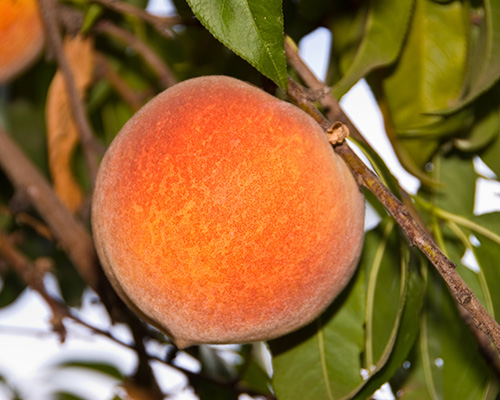
Summerset Peach - September 19th photo
Another late peach is the Indian Blood Cling Peach. It ripens in Late August into Early September. It is a large peach with red skin and dramatic blood-red flesh streaked with white. A heavey producer of good quality peaches. Will fruit heavier with a pollinizer. Requires about 900 hours of winter chill below 45ºF which prevents growing in mild winter areas.
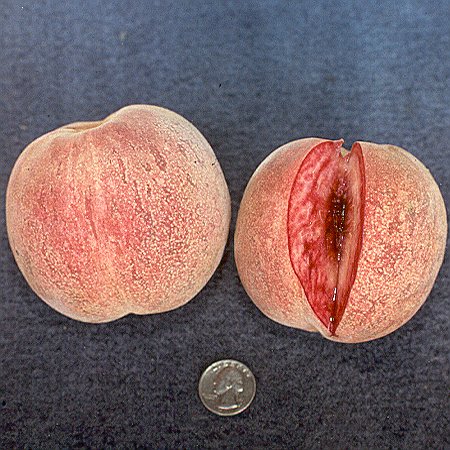
Indian Blood Cling Peach - Early September Photo
Enjoy your yummy harvest!
Jujubes, Figs and Izu Persimmons
October Ripening Fruit
This time of year I wonder if we would be smart to open a roadside fruit stand.
From May through the end of November we have fresh fruit at our fingertips (tough job isn't it?) but it is this time of year the local Farmers Market street vendors knock on our door seeking permission to pick fruit. All summer, when we have mouth watering fresh apricots, nectarines, peaches and plums, they are nowhere to be found. Guess they grow enough of their own.
But this time of year they flock to our doors seeking permission to pick Jujubes and Figs.
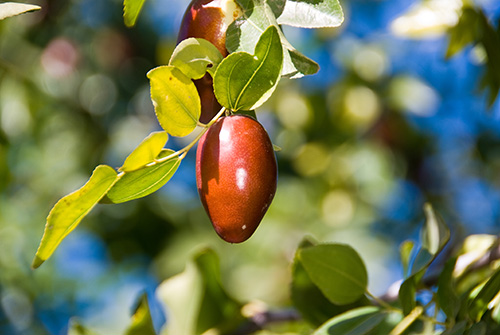
Right now the street vendors are picking the Li, Lang and GA-866 Jujube from our budwood orchard trees. Too early still for the Sherwood. (We have not told them about our young crop of Sugar Cane Jujube. We are hoarding them for ourselves although Denise claims she mailed some samples to some of her customers.)
What is always amazing to me is that in another week or two they will also be harvesting fruit from the new 9 month old trees in our growing fields. They set fruit that early in life! See the next two photos.
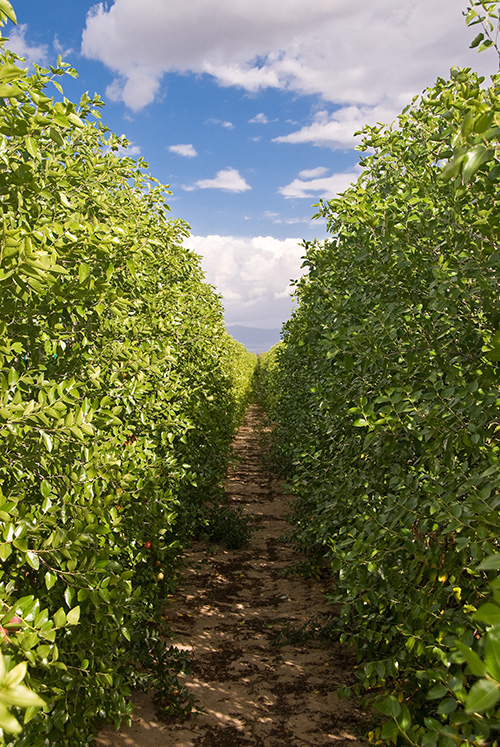
Li Jujube already setting fruit in the production rows. These trees were only grafted early last February!
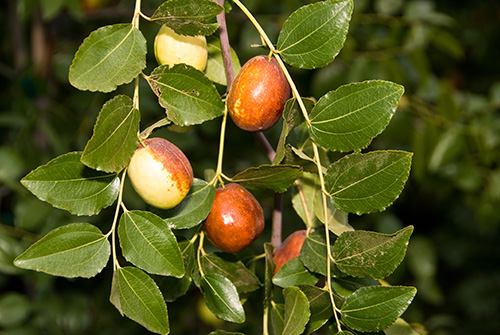
Li Jujube already starting to ripen on the 9 month young production field trees.
Figs are continuously ripening this time of year as well and the Farmers Market vendors do well selling them.
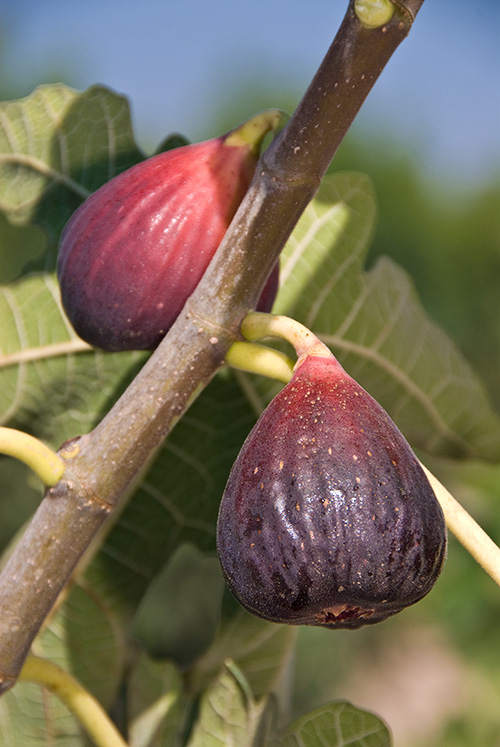
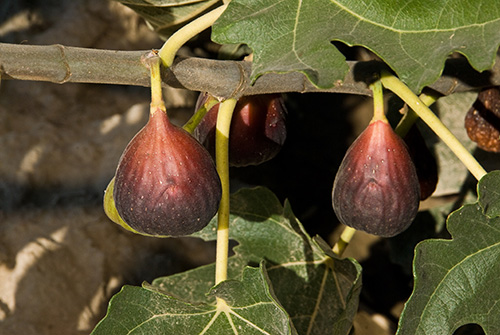
Black Jack Figs in October
One street vendor found enough late hanging Asian Pears to make his day. I'll bet they were good and sweet! Some purchasers are in for a real treat.
I have also noticed that the Izu Persimmons in the budwood orchard are nearly ready - as expected, a month ahead of the other Asian Persimmons.
Guess I better quit writing and go pick some fruit for my wife.
Sugar Cane Jujube
Ziziphus jujuba 'Sugar Cane'
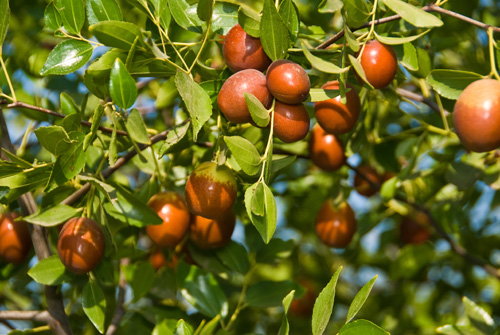
This exciting tree will be a new offering for the 2011 shipping season (sorry - not 2010).
The trees you see here were just planted January 23, 2008! The amount of fruit the second year is impressive. These trees will be supplying the graft wood for the trees to be sold in 2011. Based upon the rapid growth, if we have enough seedlings, we should get a good sized initial crop to sell.
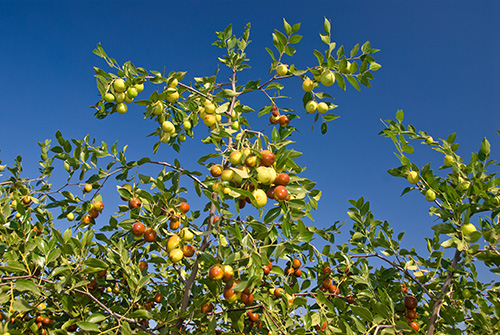
These photos were taken last Thursday 9/17/09 showing that this variety fruits earlier than the others (normally October and later). Each tree seems to have a lot of fruit in various stages of ripening. Fully ripe, half ripe and a lot of green which promises for more to come. Not sure the commercial farmer will like that, but it will be great for the home owner. Since these trees are so young, it is premature to know if this is normal for a mature tree.
I also noticed that the thorns are much, much smaller than Li or Lang Jujube. So far they are tiny. They are not lethal to tractor tires on this variety. Again, I'll wait for older trees to see if this holds true over time.
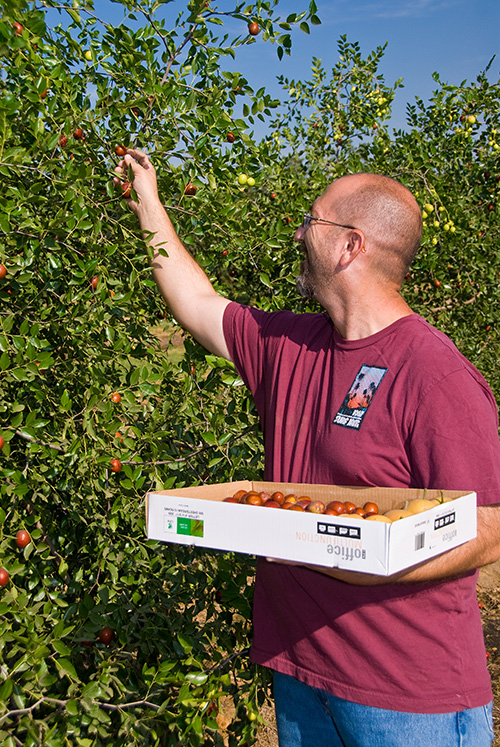
Lloyd is harvesting Sugar Cane Jujube for samples to try in the office. You can see a substantial amount in the box. He filled it before that picking was finished. That evening I went to the box to take some home for my wife to try and only 3 Jujube fruits were left. Clearly the office staff loved them.
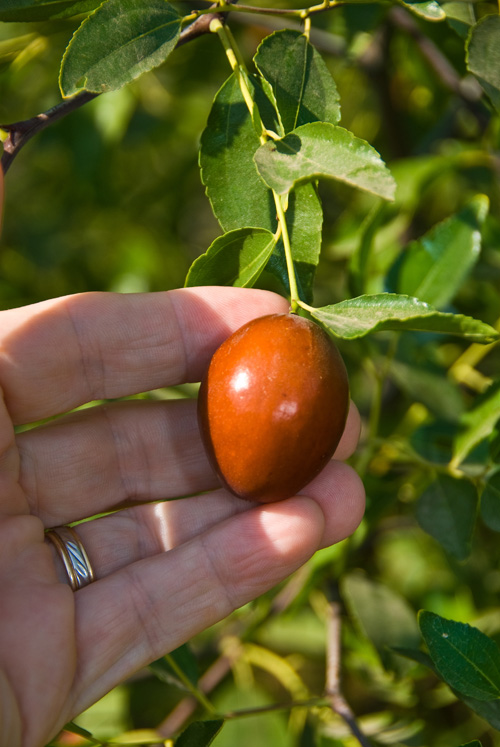
The name Sugar Cane is fitting. The fruit is clearly very sweet - something I really go for. For those of us who like sweet fruit, the Sugar Cane became our favorite of all the Jujube varieties we grow.
Jujube fruit is very popular among the Asian cultures and I think has been somewhat of an "acquired taste" for the American cultures. Based upon the response to our tasting, Sugar Cane Jujube will be an instant hit with all cultures - at least if you like sweet fruit. I am really excited about this product.
To get a feel for demand so we can attempt to produce enough, we are taking advance bookings now for January 2011 delivery. Our goal will be to produce enough initial stock to distribute widely in at least limited quantities before we offer commercial quantities. If your nursery is interested, give us a call.
Vitex agnus-castus
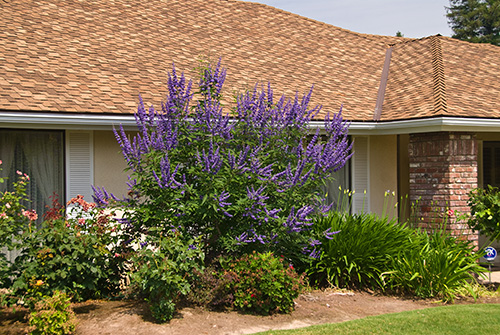
When I was asked to consider growing Vitex not all that many years ago, I confess I had to look it up. As I read various descriptions, the feature that jumped out at me was the very wide range of climates that this large shrub/small tree grew well in. I remember reading that it had a range from Washington State to the Desert Southwest with even more prolific blooming in the hotter climates. As a nursery grower that ships to nearly every climate in North America, that sounded intriguing, maybe even promising. Vitex is hardy in U.S.D.A. Zones 6-10.
Time has now passed and we have become very familiar with Vitex agnus-castus (often just called Vitex). In past years I was impressed with some large shrubs in the neighborhood that I mistakenly thought were Butterfly Bush (Buddleia) and its prolific, early summer blooms. Now I recognize them as they truly are, Vitex agnus-castus. Taking a look at the blooms can illustrate the confusion.
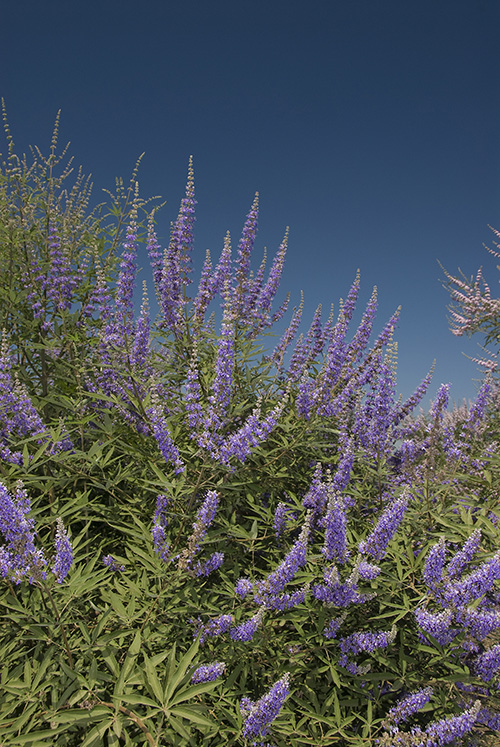
As you can see, Vitex is noteworthy for its showy, summer display (late springtime in the deep South) of fragrant, upwardly pointing, terminal panicles of lavender blooms. These blooms are quite attractive to butterflies, bees and Humming Birds. The tree is sometimes planted where honey is marketed to promote excellent honey production.
Starting in early summer, flowers begin opening from the bottom of the flower stem and continue up the stem over the course of four or five weeks until the bush is completely blanketed in eye-popping bloom. Harvesting these flowers early in the bloom cycle is the best way to preserve them for craft use. They may be used fresh or hung upside down in small bunches for drying. Many aromatic black or brown seeds may be set, but if the spent spikes are cut off promptly after the first flowering the shrub will bloom again.
What About Colors?
Most Vitex is grown from seed and usually provides a lavender - purple - blue bloom. We started our experience with Vitex from seed and still offer seed grown Vitex in bush and tree forms. We also discovered the seedlings which usually provided lavender blooms can also produce a wide variance in colors - something not always appreciated if your bloom does not meet expectations.
Over time we have collected the best colors and now have an outstanding White selection and an outstanding Pink selection grown by clonal reproduction.
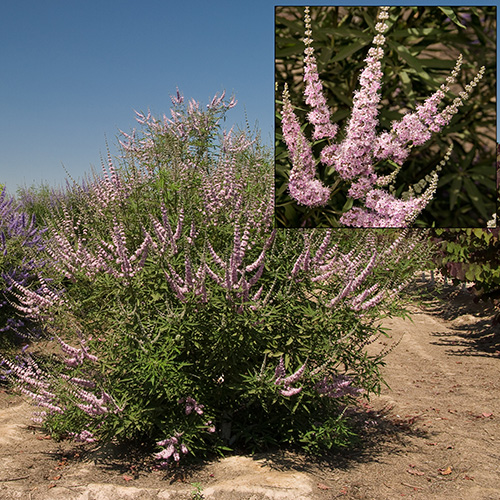 Cooke's Selection Pink Vitex
Cooke's Selection Pink Vitex
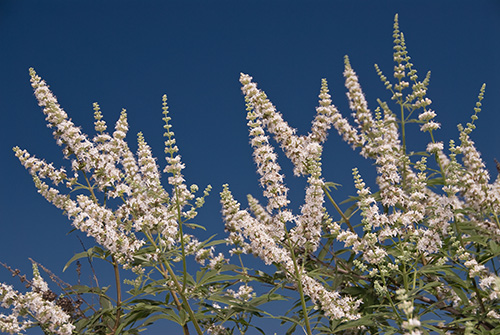
Cooke's Selection White Vitex
These Pink and White selections are truly unique, very attractive and growing in popularity as they are more widely seen. They stand out in our scion wood orchards.
Although Vitex normally blooms as lavender-blue, we are trying to guarantee the best colors. So clonal production of excellent Purple and Blue selections are being offered too. We are still selecting the best single parent plant for each color as we have 3 to 4 plants of each that have risen to the top to choose between. I am finding this a bit more difficult as an excellent Purple today looks bluer when it fades in the following weeks. None-the-less, a "Select" Blue or "Select" Purple from our catalog will not disappoint by coming out some unknown shade of color as can happen with the seed grown product.
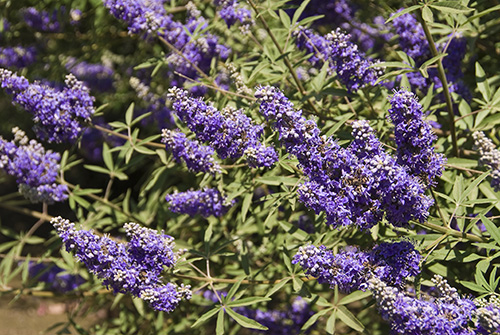
Still trying to select the best Blue and the best Purple
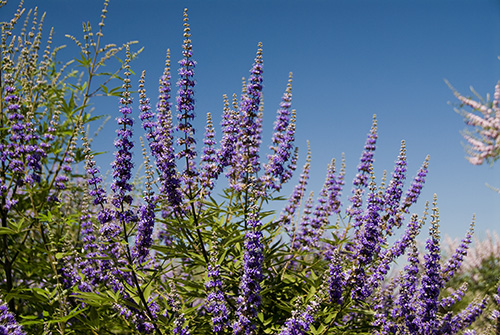
Where Did The Various Names Come From?
The common name "Chaste Tree" has its roots in antiquity. The species name Agnus castus originates from the Greek agnos castus, meaning chaste, as the Greeks thought the plant calmed sexual passion. Athenian women used the leaves in their beds to keep themselves chaste during the feasts of Ceres.
As the flowers of summer fade, small dark purple berries follow. In the past these berries have been dried and used as a rather weak substitute for pepper and as an ingredient in Mediterranean spice mixtures. In the 6th century, the ground dried berries were touted as a must for monks trying to maintain their vows of chastity - thus, the common name Monk's Pepper.
The aromatic, sage scented, leaves are palmate, with five to seven leaflets. At first glance it is often mistaken for Hemp/Marijuana thus it is sometimes called Hemp Tree. Those trying to smoke the leaves have been disappointed.
For over 2500 years Vitex has been considered a vital herb for its various medicinal properties - which is beyond the scope of this article. If you want to explore other uses beyond beautifying landscapes, just Google search on Vitex and see all the possible other proven and some unproven benefits.
Growing Vitex
Vitex grows naturally as a large, multi-stem shrub from 10 to 15 feet tall and 10 to 20 feet wide. It can also be trained into a tree which will also reach 10 to 15 feet tall and about as wide. We grow it both ways - tree and shrub forms in all four color choices.
Vitex should be grown in full sun or partial shade.
We have found Vitex to be a very accommodating and tough plant. It is native to woodlands and dry areas of southern Europe and western Asia. It is easy to grow in almost any soil that has good drainage. Even tolerant of salt drift. Vitex is very drought tolerant once established but can handle lots of water if well drained. The chaste tree can nearly take care of itself, but can be pushed to faster growth with light applications of fertilizer in spring and early summer and by mulching around the plant.
If pruning is desired to control the size and shape, it should be done in winter, since blooms form on new wood.
As with most plants and trees, there are appropriate locations for this tree and others not recommended. Since this plant sets seed, it can self propagate in the right environments. Although I have not found it on any official lists, in some climate areas it is being discussed for invasive species status.
No pests are of major concern. It can get root rot in poorly drained soil. Leaf spot can be a problem in some climates. Surface roots are usually not a problem.
Usage
Because of its many admirable attributes, Vitex is a garden favorite wherever in the world it can be grown. The showy Chaste Tree makes a particularly effective specimen - use it as the centerpiece of a lawn or in large containers. Plant near patio or deck where it can be seen but not too close though as it can attract crowds of hungry bumble bees.
It makes a colorful addition to a mixed border if kept pruned to shrub size. In bush form, Vitex probably looks best unpruned. Leave it to sprawl and it will eventually form a large green sphere of foliage and flower. It is recommended for buffer strips around parking lots or for median strip plantings in the highway.
Beautiful and tough. Vitex agnus-castus has features to meet your landscape needs.
More information can be found on L.E. Cooke Co and more photos on www.CreatorsPalette.com
Stop! Is That a Pomegranate?
"Stop! Is that a Pomegranate?"
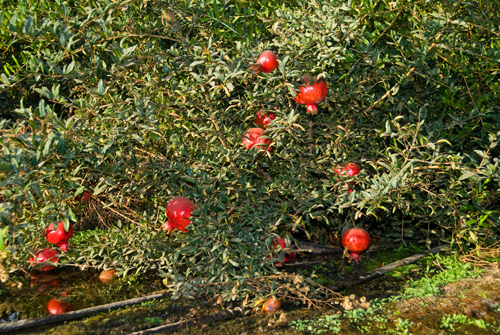
Yesterday, Lloyd, Tom and I took a buyer around the fields from one of the nationally recognized wholesale nurseries. Of course we were all looking at the shades and ornamental trees - things that they buy. They were not looking for fruit trees (although in today's economy they were wistfully wishing they were).
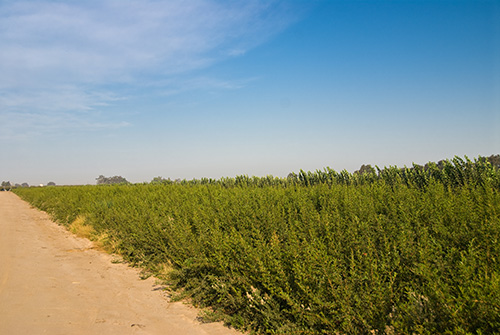
(1/4 mile long rows of 2 year pomegranates)
As we entered another one of the fields, the excited exclamation came to stop and look. The buyer was pointing to the quarter mile rows of Angel Red® Pomegranates - many of which already had ripe fruit on them. This is September 9th - and these young plants (less than 2 years) were already fruiting.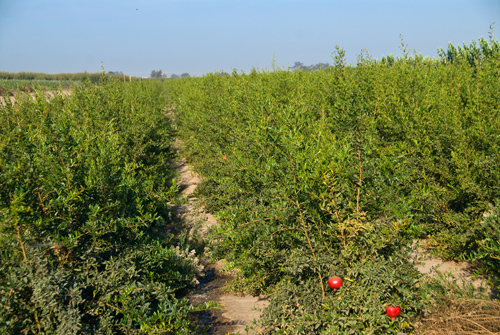 (Photo doesn't show it, but nearly every plant has 1 to 5 pomegranates on it)
(Photo doesn't show it, but nearly every plant has 1 to 5 pomegranates on it)
Needless to say, we stopped and picked a few fruits and admired how red they were - especially on such a juvenile plant so early in the season. The buyer took the long drive home happily carrying handfuls of the precious cargo with anticipation of the treat ahead. Hmm...wonder how safe it was to drive and eat pomegranates?
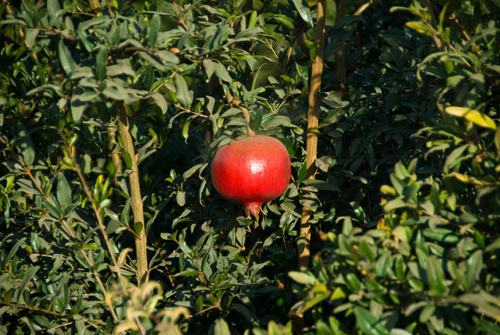
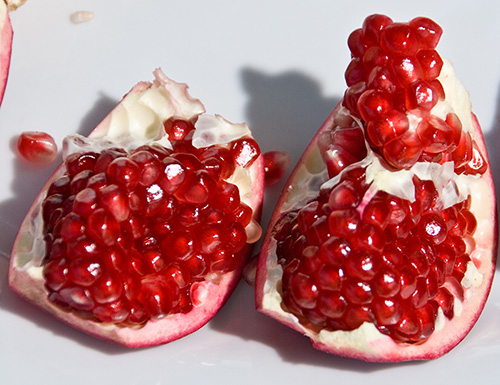
Angel Red® Pomegranates, in my opinion, should become one of the favorite pomegranates across our country. Sales statistics show that it is well on its way to the top.
Why? Ripens a month ahead of Wonderful, gorgeous red color, sweeter and soft seeded. And the mature bush is not as humongous as Wonderful (12-14' vs 18'). A winner in most every way.
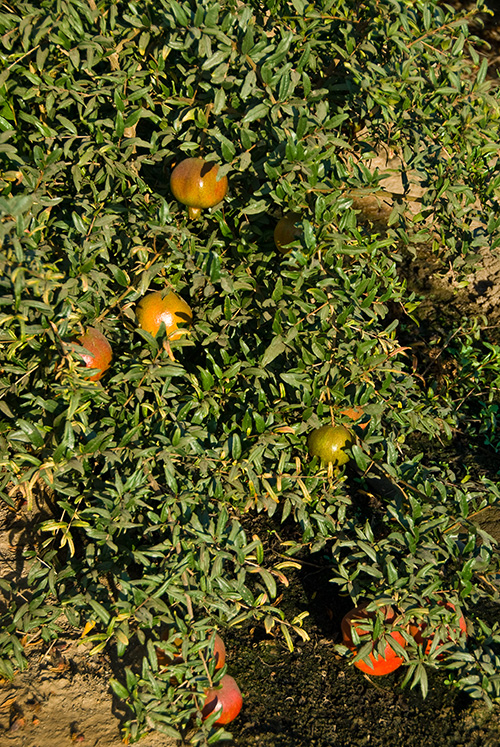 (Here is a comparison to Wonderful 5 rows away - far from ripe)
(Here is a comparison to Wonderful 5 rows away - far from ripe)
Any negatives? With one less month of growth, the fruit does not size up as large as the Wonderful (neither do other early pomegranates). But they still get very large, just not huge. Very attractive and sized for commercial sales. I have some concern that the new foliage in the spring may be more susceptible to uncommonly late frosts - at least the last two years we saw very out-of-the-ordinary frosts late in the season which nipped them more than the others.
More information here: Angel Red Pomegranate
Massively Fruiting Granny Smith Spur Apple
I have got to show you this tree! 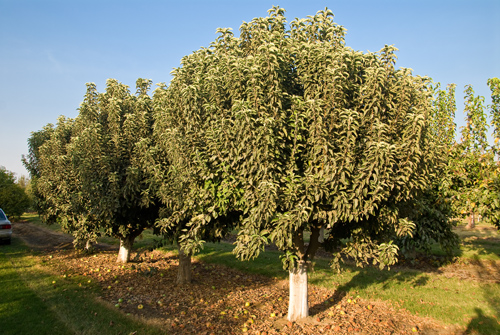
Not too impressed? OK, I should have said the fruit on the tree:
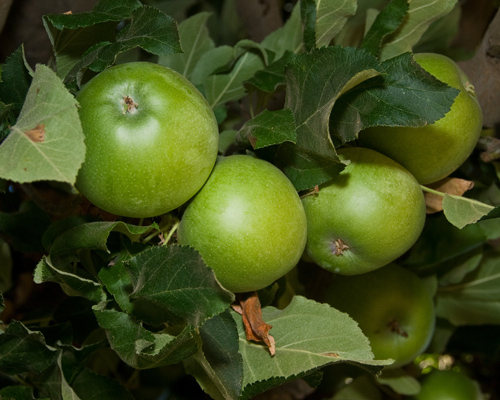
Every year at the end of October or early November I bring visitors and staff to see the Granny Smith Spur Apple. Take a look under/inside the tree:
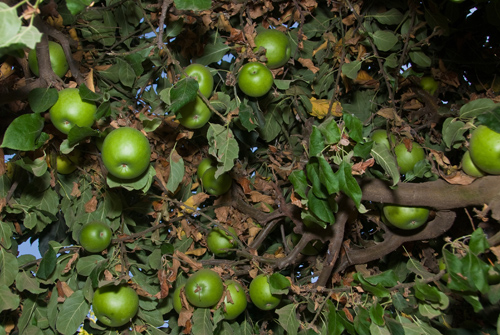
It fruits like crazy! Perfect, juicy, tangy, Granny Smith Apples. Look at how loaded it is. And you have to remember that this tree had most of its wood cut off each year to produce vegetative growth for the annual budding needs.
This tree is a perfect example of what a Spur Apple does. In our hot valley, we rarely get apples that taste good after the long hot summer. If it fruits in the fall season, most apples are not good through our summer heat. But Spur Apples are different.
Spur apples produce fruit on the inside of the tree - well shaded from the blistering sun. Spur Apple trees are also smaller growers making it much easier to reach fruit at harvest time. The apples are not smaller - just the tree. Spur Apple trees are naturally semi-dwarf which is why you find them on Common Apple rootstock instead of semi-dwarfing rootstock.
If you look at our recommended variety lists for California's Central Valley and other hot summer areas with appropriate chilling, you will find Spur Apples at the top of the list.
Just in time for Halloween and fall festival pies. Yumm.
Nice apple bloom too in the spring:
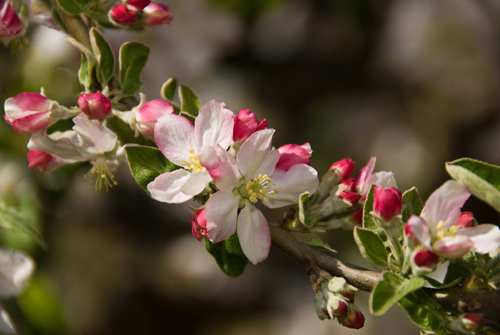
Enjoy!

